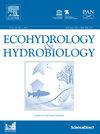Modelling wetland eco-hydrological state and its role on ecosystem service potentiality
IF 2.2
4区 环境科学与生态学
Q2 ECOLOGY
引用次数: 0
Abstract
The application of the machine learning model for modelling environmental susceptibility is widespread. However, its application coupling with the Pressure-State-Response (PSR) framework for modelling wetland eco-hydrological state (EHS) is rare but it is necessary for wetland management and restoration. Dam-induced hydrological modification is a crucial driver of EHS change. How EHS conditions can control ecosystem services potentiality (ESP) including provisioning, regulating and cultural services is another vital unresolved issue that needs to be analysed for the well-being of the people. Considering this, the present study tried to model the EHS of wetlands in the Tangon River of India and Bangladesh blending both machine learning algorithms and PSR framework. It also aimed to assess the influence of EHS on ESP. Tangon River is a floodplain river, which is hydrologically intervened through the Boda dam in the Panchagarh district of Bangladesh, which causes hydrological modification in the river and riparian floodplain wetlands. All the applied models successfully explored that 28.90% to 47.89% of the wetland area under a very good EHS zone was reduced to 28.90 % to 31.41%, indicating the gradual degradation of EHS quality over a wider part of the wetland after hydrological intervention. The performance of the applied models is acceptable, but REPTree and Bagging models were found best-performing models for EHS modelling. This study also established that the EHS condition of the wetlands positively influences the ESP of the wetlands. So, improvement of EHS is a way forward for promoting the serviceability of the wetland.
模拟湿地生态水文状态及其对生态系统服务潜力的作用
机器学习模型在环境敏感性建模中的应用非常广泛。然而,将其与压力-状态-响应(Pressure-State-Response, PSR)框架耦合用于湿地生态水文状态(EHS)建模的应用很少,但这是湿地管理和恢复所必需的。大坝引起的水文变化是EHS变化的关键驱动因素。EHS条件如何控制生态系统服务潜力(ESP),包括供应、调节和文化服务,是另一个重要的未解决问题,需要对人们的福祉进行分析。考虑到这一点,本研究试图将机器学习算法和PSR框架混合在一起,对印度和孟加拉国Tangon河湿地的EHS进行建模。Tangon河是一条洪泛区河流,在孟加拉国Panchagarh地区的Boda大坝对其进行了水文干预,导致河流和河岸洪泛区湿地的水文改变。所有应用模型都成功地发现,EHS非常好的湿地面积从28.90% ~ 47.89%减少到28.90% ~ 31.41%,表明在水文干预后,湿地的EHS质量在更大范围内逐渐退化。应用模型的性能是可以接受的,但REPTree和Bagging模型被发现是最适合EHS建模的模型。研究还证实了湿地的EHS条件对湿地ESP具有正向影响。因此,改善EHS是提高湿地可使用性的一种途径。
本文章由计算机程序翻译,如有差异,请以英文原文为准。
求助全文
约1分钟内获得全文
求助全文
来源期刊

Ecohydrology & Hydrobiology
Agricultural and Biological Sciences-Aquatic Science
CiteScore
5.40
自引率
3.80%
发文量
51
期刊介绍:
Ecohydrology & Hydrobiology is an international journal that aims to advance ecohydrology as the study of the interplay between ecological and hydrological processes from molecular to river basin scales, and to promote its implementation as an integrative management tool to harmonize societal needs with biosphere potential.
 求助内容:
求助内容: 应助结果提醒方式:
应助结果提醒方式:


